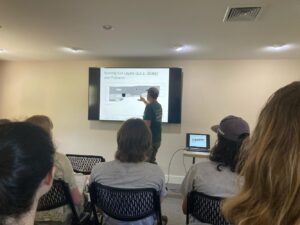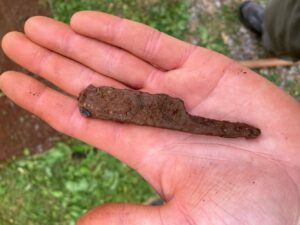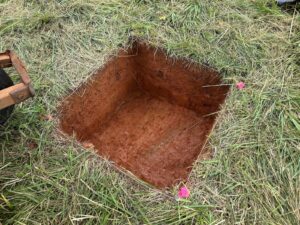Archaeology Blog
2024 Field School Week 1
By: Ryan Guard and Jonathan Mayes
On June 3rd 2024, fifteen enthusiastic students arrived for the beginning of the 2024 Poplar Forest Summer Field School in Historical Archaeology. After a morning of introductory lectures by Dr. Eric Proebsting and a laboratory tour by Archaeology Laboratory Supervisor Karen McIlvoy, the students were introduced to fieldwork through the opening of eight 2 ft. x 2 ft. test units in the southeast curtilage in an area located near previously identified archaeological features. These features included a Jefferson-era ornamental plant nursery and a large, filled-in gully near the edge of the original core of the property as well as evidence of another nearby building dating to this period of the plantation’s history.
In 1812-1813, Thomas Jefferson designated a 61-acre curtilage surrounding the core of the property. The curtilage was defined by a fence line that bisected a previously existing quarter for enslaved individuals. After the curtilage was established, it is possible that new buildings were erected in the vicinity of the southeast curtilage, where the field school students excavated their first units. In their 2 ft. x 2 ft. units, students recovered wrought and cut nails, creamware, and pearlware that could date to the late 18th or early 19th century.
By June 6th, most field school students (with the exception of a few poor souls who encountered incredibly deep soils) completed their Southeast southeast Curtilage curtilage units and moved to units around the 1857 Slave Dwelling. The 1857 Slave Dwelling, along with the neighboring North Tenant House that was occupied by the overseer and his family, was constructed during Edward Hutter’s ownership of the plantation. During unit excavation around the 1857 Slave Dwelling, students recovered ceramic sherds, glass shards, cut and wrought nails, brick and mortar fragments, a knife fragment (see below for image), and other artifacts potentially associated with the construction and habitation of the dwelling.
The students look forward to beginning a new week of excavations and hope to uncover more artifacts and features around the 1857 Slave Dwelling, the main focus of this summer’s field school.


